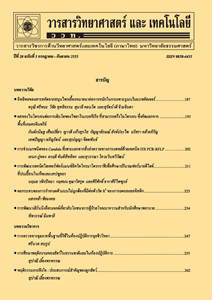ผลของความเข้มข้นสารละลาย KNO3 และระยะเวลาในการเตรียมพร้อมเมล็ดพันธุ์ต่อคุณภาพของเมล็ดพันธุ์พริกหวาน
Main Article Content
บทคัดย่อ
ศึกษาผลของความเข้มข้นสารละลาย KNO3 และระยะเวลาในการเตรียมพร้อมเมล็ดพันธุ์ต่อคุณภาพของเมล็ดพันธุ์พริกหวานพันธุ์ California เพื่อปรับปรุงให้เมล็ดงอกได้เร็วขึ้น โดยจัดสิ่งทดลองแบบ 2 × 3 แฟคทอเรียลในแผนการทดลองแบบสุ่มสมบูรณ์ โดยเมล็ดที่ไม่เตรียมพร้อมเมล็ดพันธุ์เป็นวิธีควบคุม (control) มี 2 ปัจจัย ได้แก่ ปัจจัย A คือ ความเข้มข้นของสารละลาย KNO3 มี 2 ระดับ คือ 0 เปอร์เซ็นต์ และ 3 เปอร์เซ็นต์ และปัจจัย B คือ ระยะเวลาในการแช่เมล็ด มี 3 ระดับ คือ 24, 48 และ 72 ชั่วโมง พบว่าการเตรียมพร้อมเมล็ดพันธุ์ด้วยสารละลาย KNO3 ความเข้มข้น 3 เปอร์เซ็นต์ เป็นเวลา 24, 48 และ 72 ชั่วโมง ไม่มีผลทำให้เมล็ดงอกได้สูงขึ้น แต่การเตรียมพร้อมเมล็ดพันธุ์ด้วยสารละลาย KNO3 ความเข้มข้น 3 เปอร์เซ็นต์ เป็นเวลา 72 ชั่วโมง มีผลทำให้เมล็ดมีจำนวนวันที่มีรากงอกและมีเวลาเฉลี่ยในการงอกเร็ว 11.00 และ 16.03 วัน ตามลำดับ
Article Details
เอกสารอ้างอิง
Rasameethummawong, P., 2007, Planting and Propagation of Pepper, Petchkarat Publishing Co. Ltd., Bangkok. 104 p. (in Thai)
Copeland, L.O. and McDonald, M.B., 1995, Principles of Seed Science and Technology, Springer Science & Business Media, New York.
Bradford, K.J., 1986, Manipulation of seed water relation via osmotic priming to improve germination under stress condition, Hort. Sci. 21: 1105-1112.
McDonald, M.B., 2000, Seed Priming, pp. 287-325, In Black, M. and Bewley, J.D. (Eds.), Seed Technology and Its Biological Basis, Sheffield Academic Press, England.
Saleh, M.M., Abou-Hadid, A.F. and El-Beltagy, A.S., 1996, Sweet pepper emergence and seedling growth after seed pre-germination, Acta Hort. 434: 335-340.
Korkmaz, A., 2005, Inclusion of acetyl salicylic acid and methyl jasmonate into the priming solution improves low temperature germination and emergence of sweet pepper, Hort. Sci. 40: 197-200.
Ameri, A., Fatemi, H., Aroiee, H. and Silva, J.A.T., 2011, What’s the effect of saline priming on germination factors of Capsicum annuum var. ‘California wonder’ seed?, Seed Sci. Biotechnol. 5: 47-49.
ISTA, 2018, International Rules for Seed Testing, The International Seed Testing Association (ISTA), Basserdorf, 298 p.
Dhillon, N.P.S., 1995, Seed priming of male sterile muskmelon (Cucumis melo L.) for low temperature germination, Seed Sci. Technol. 23: 881-884.
Ellis, R.H. and Roberts, E.H., 1980, Improved equations for the prediction of seed longevity, Ann. Bot. 45: 13-30.
Chotanakoon, K., 2016, Effect of Seed Priming on Germinability, Storability and Seedling Growth of Pepper (Capsicum annuum L. cv. Bang Chang), Master Thesis, Kasetsart University, Bangkok, 91 p. (in Thai)
Basu, R.N. and Pal, P., 1979, Physiological control of seed deterioration in rice, Indian J. Agric. Sci. 49: 1-6.
Trawatha, S.E., Steiner, J.J., and Bradford, K.J., 1990, Laboratory vigor tests to predict pepper seedling field emergence performance, Crop Sci. 30: 713-717.
Chanprasert, W., 2010, Seed Physiology, Extension and Training Office Press, Kasetsart University, Bangkok, 167 p. (in Thai)
Varier, A., Vari, A.K. and Dadlani, M., 2010, The subcellular basic of seed priming, Curr. Sci. 99: 450-456.
Prapanoppasin, P., 1999, Studies on Pepper Seed Priming by Hydropriming and Osmoconditioning, Master Special Problem, Kasetsart University, Bangkok, 24 p. (in Thai)


